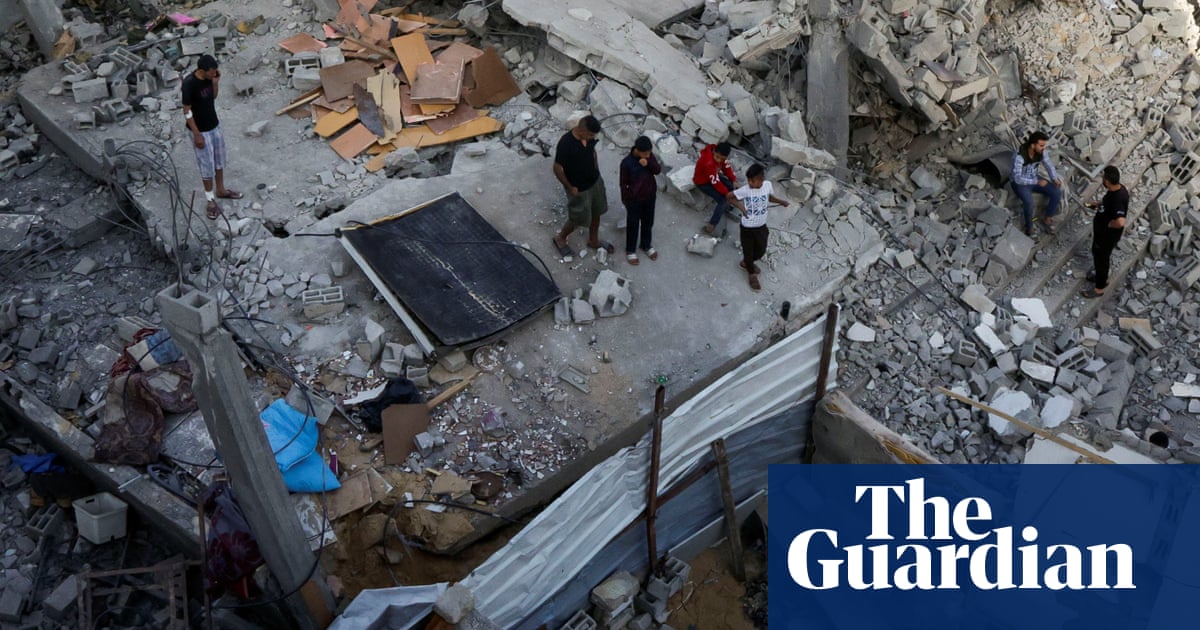Israeli airstrikes have killed at least 40 people across Gaza during the past 24 hours, civil defence officials in the devastated Palestinian territory said, as Israel’s government prepared to order an expansion of its military offensive.
Nine people were killed when a strike hit a home in the Bureij refugee camp in central Gaza; another six people died in a separate strike targeting a family home in the northern city of Beit Lahiya; six more died in a strike on a community kitchen inGazaCity, and an overnight attack on the Khan Younis refugee camp killed at least 11 people including three babies up to a year old, the officials said.
Asked to comment on the strikes, an Israel Defense Forces (IDF) spokesperson said the military “takes feasible precautions to mitigate civilian harm”.
Israelresumed its bombing campaign in Gazaon 18 March, ending a fragile ceasefire. Since then, at least 2,326 people have been killed, bringing the death toll since the war broke out to 52,418, according to the health ministry in Gaza.
Israel has accused Hamas of using civilians as human shields, a charge denied by the radical Islamist organisation. It also accuses Hamas of stealing and selling aid to fund its military and other operations.
The war was triggered by a surprise attack launched by Hamas into Israel on 7 October 2023. Militants killed more than 1,200 people on the Israeli side, mostly civilians, and abducted 251 people, 58 of whom are still held in Gaza, including 34 whom the Israeli military says are dead.
Aid officials have warned of a humanitarian catastrophe in Gaza, with famine again looming. On Friday, the International Committee of the Red Cross (ICRC) warned that the humanitarian response in Gaza was on the “verge of total collapse”.
“This situation must not – and cannot – be allowed to escalate further,” Pascal Hundt, the ICRC’s deputy director of operations, said in a statement.
There has been no progress in faltering negotiations for a new ceasefire-for-hostages deal in recent weeks, and reports in Israeli media suggest Benjamin Netanyahu, the prime minister, will soonapprove a new broader offensiveas well as a new plan drawn up by Israeli officials for renewed distribution of aid in Gaza involving private contractors and a small number of “hubs” to be constructed in the south of the territory.
Humanitarian officials in Gaza told the Guardian last week that the proposed Israeli aid plan was impracticable and unethical.
“The current scheme just won’t work unless there are a lot more distribution hubs and even then we cannot be a party to something that may drive massive and possibly permanent displacement within Gaza,” one senior humanitarian official said.
The US president, Donald Trump, is thought to be likely to press Israel for some concessions on aid entering Gaza before he visits Saudi Arabia, the UAE and Qatar this month. A week ago, he told Netanyahu to be “good to Gaza”.
Analysts are divided on whether warnings issued to tens of thousands of Israeli reservists to expect to be called up in the coming days or weeks are designed to put further pressure on Hamas to make concessions in talks or are evidence that a new offensive in Gaza is imminent.
Israel’s military is already overstretched after 18 months of war, with a shortfall of about 7,000 combat soldiers. Government officials describe a “seven-front war” thatcould last another year.
On Saturday morning, sirens sounded in Israel for the second day running, warning of an incoming missile launched by Iran-backed Houthi rebels in Yemen, who say the attacks are in solidarity with Palestinians in Gaza. Air defences intercepted the missile.
Separately, Israel’s military said on Saturday its forces deployed in southern Syria were ready to protect the Druze minority, without specifying whether this was a new deployment or giving further details on the number of troops on the ground.
After deadly sectarian clashes near Damascus earlier this week,Israel has conducted multiple strikes it says were meant to protect the Druze communityand warned Syria’s Islamist rulers against harming the minority group.
On Saturday, the Israeli military said that “five Syrian Druze citizens were evacuated to receive medical treatment in Israel overnight” after sustaining injuries on Syrian territory.
A Druze official in the southern Syrian city Sweida said those evacuated had been wounded “in clashes in Sahnaya”, the site of recent sectarian violence near Damascus, but were afraid of being sent to hospitals in the Syrian capital out of fear of being detained.
Israel launched a new wave of more than 20 airstrikes in Syria late on Friday, according to the Syrian Observatory for Human Rights, a UK-based monitoring group. Early on Friday, Israel had launched an attack near the presidential palace in Damascus, which Syrian authorities condemned as a“dangerous escalation”.
Israel’s defence minister, Israel Katz, warned on Thursday that Israel would respond forcefully if Syria’s new government failed to protect the Druze minority.
Since the fall of Bashar al-Assad’s regime in December, Israel has launched repeated airstrikes on Syria. It has also sent troops to what was a demilitarised zone in theGolan Heights, on Syria’s south-west border with Israel, seizing key strategic terrain where Syrian troops were once deployed.
Analysts in Israel say the strategy aims to undermine the new Syrian government while also protecting and so co-opting a potential proxy ally within the country. The strategy is controversial, however, with some officials arguing that a stable Syria would better serve Israel’s interests.
The government in Damascus took power after ousting Assad and is dominated by the militant group Hayat Tahrir al-Sham, which has its roots in al-Qaida’s jihadist network. Though Syria’s new rulers have promised inclusive rule in the multiconfessional, multi-ethnic country, they face pressures from extremists within their own ranks.
Agence France-Presse contributed to this report
